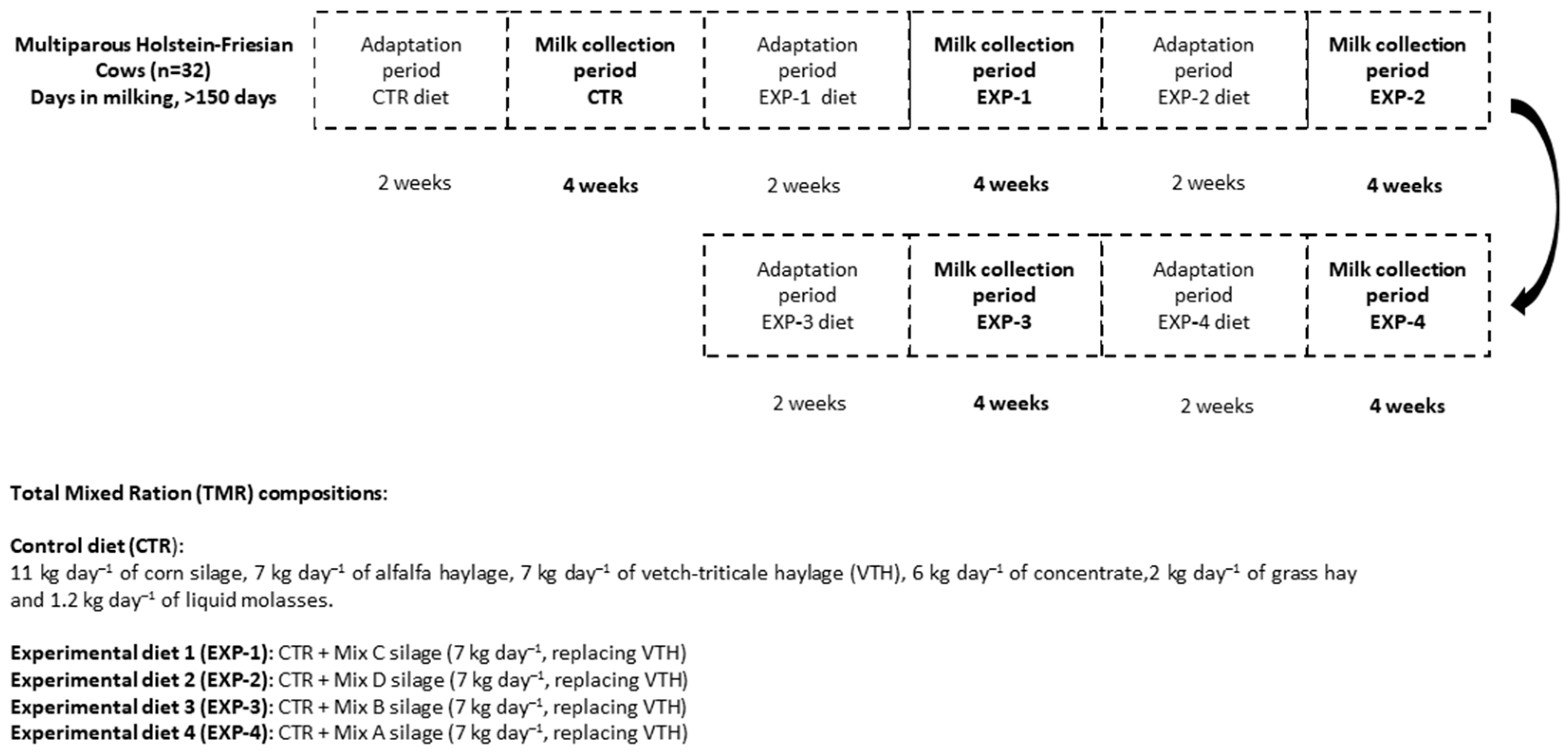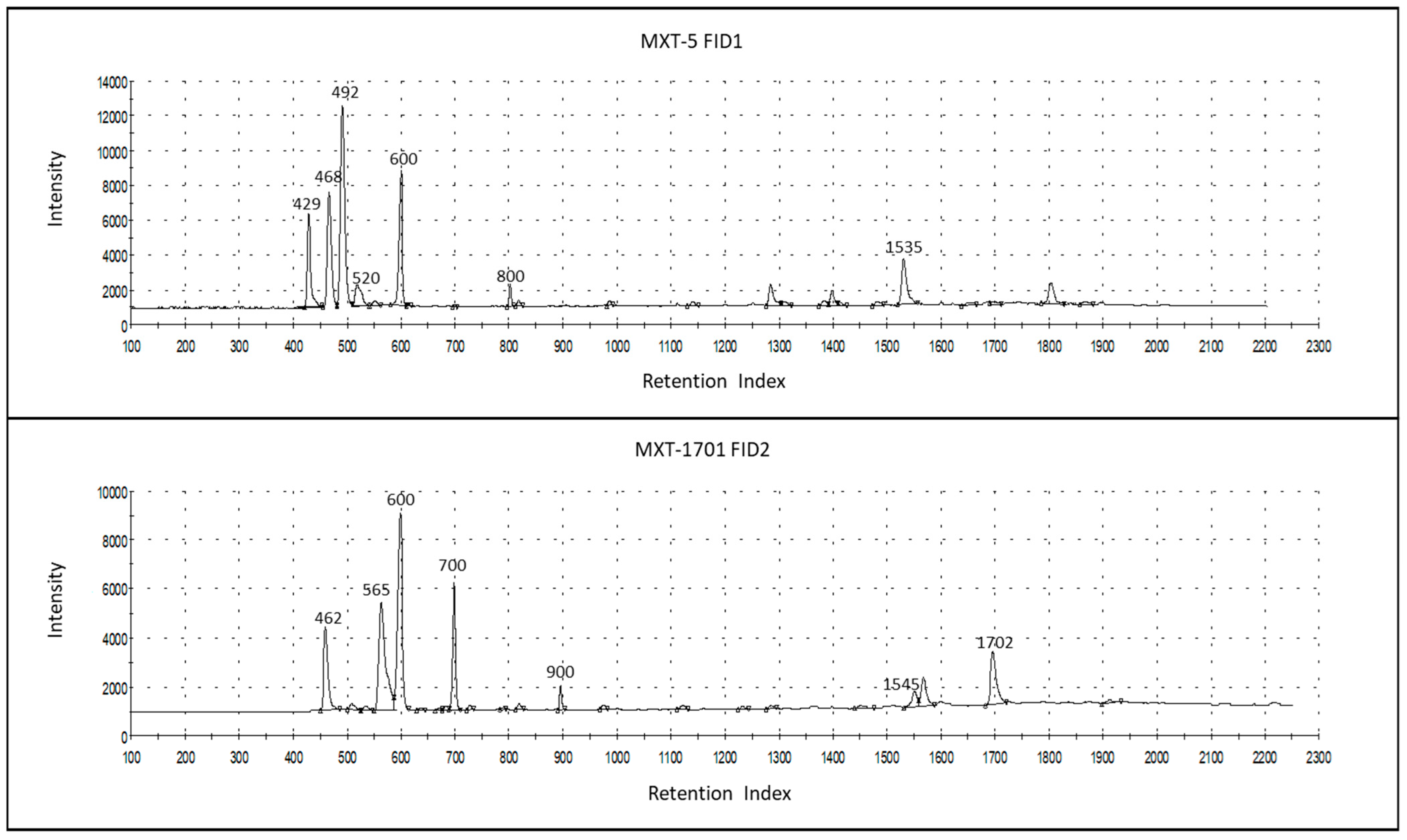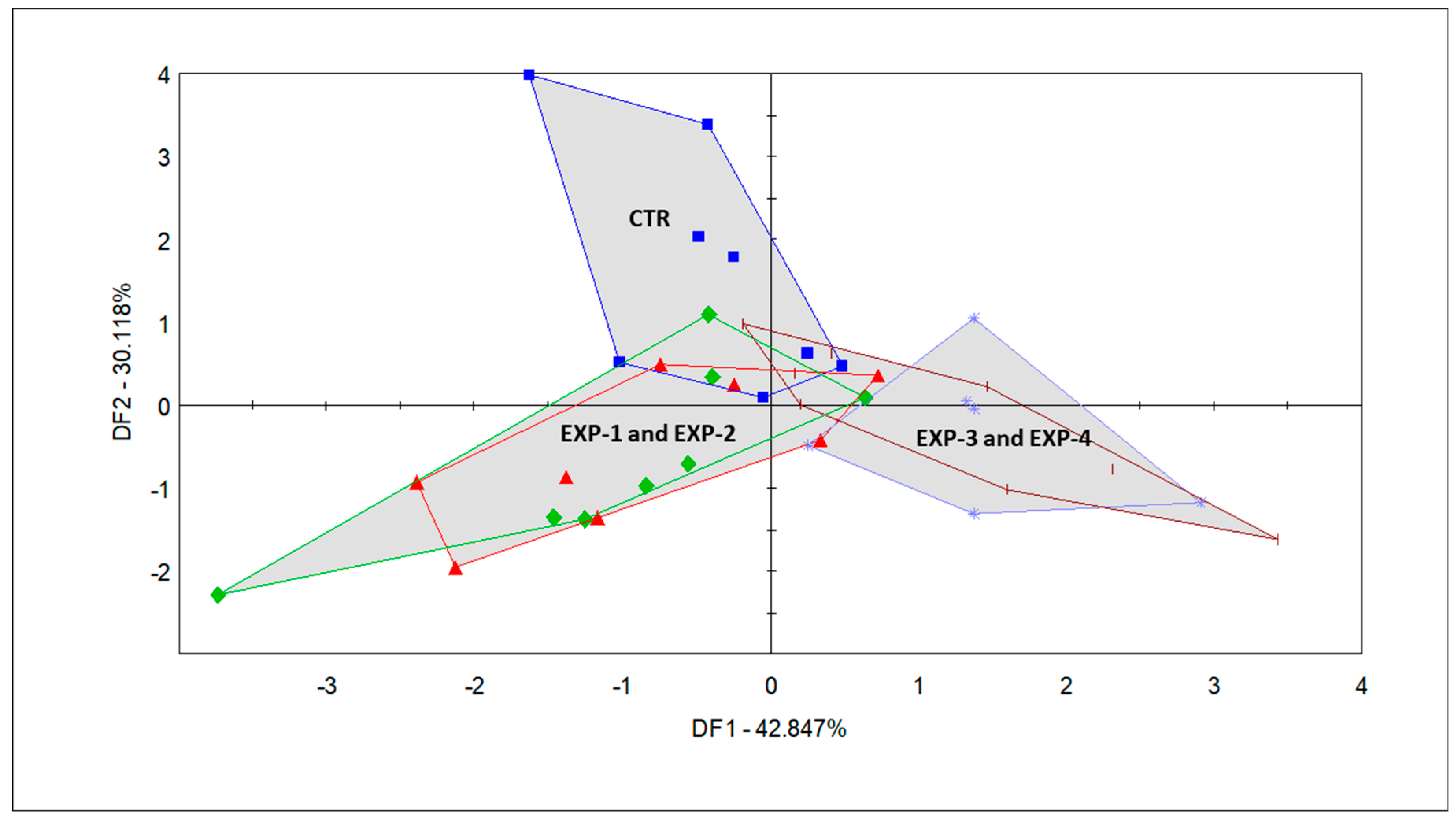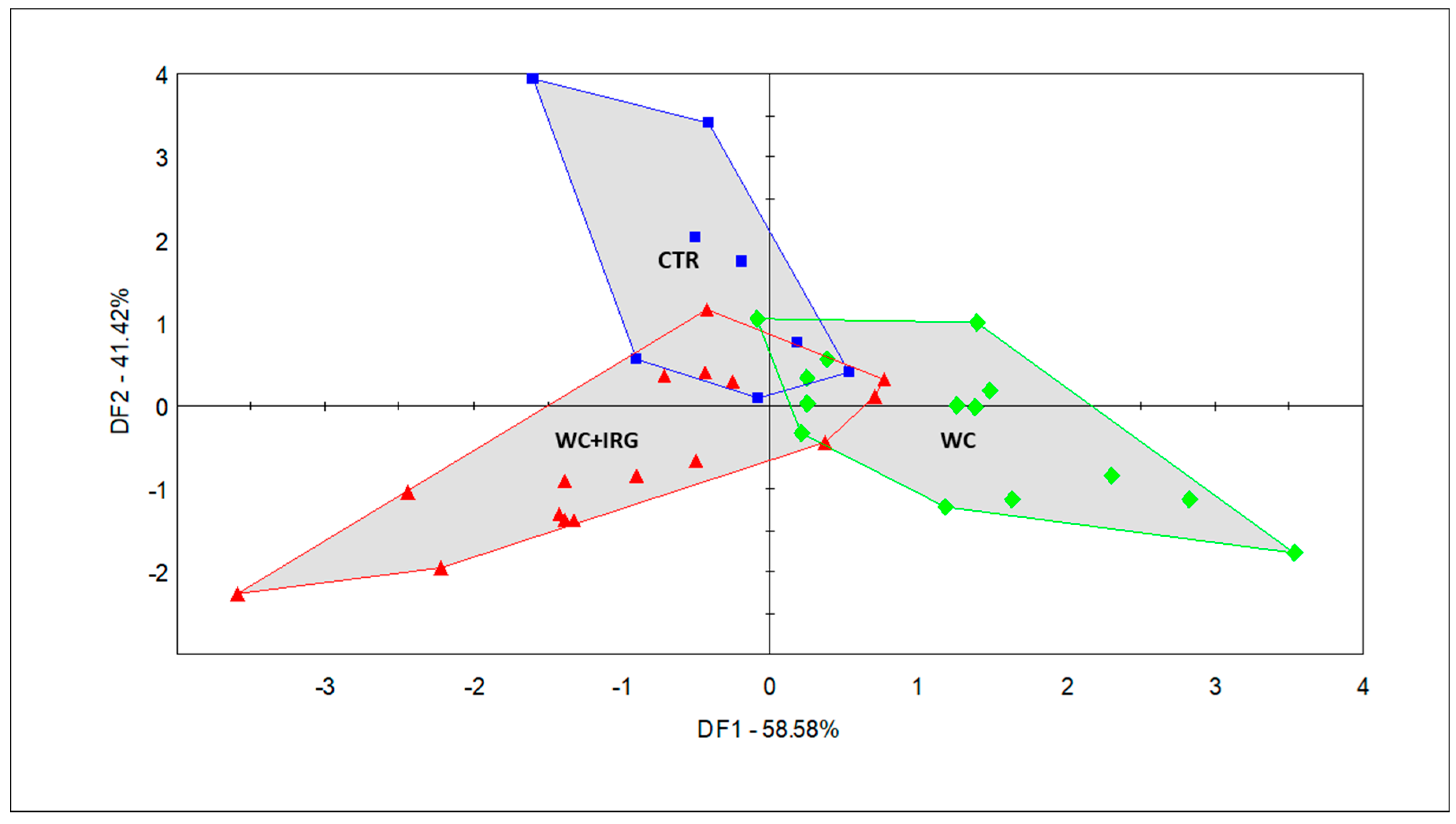Feeding Mixed Silages of Winter Cereals and Italian Ryegrass Can Modify the Fatty Acid and Odor Profile of Bovine Milk
Abstract
:1. Introduction
2. Materials and Methods
2.1. Experimental Design
- Mix A: 40% of two cultivars of winter triticale + 30% of two cultivars of winter oats + 20% of winter barley + 10% of winter wheat.
- Mix B: 50% of two cultivars of winter triticale + 40% of winter barley + 10% of winter wheat.
- Mix C: 55% of three types of Italian ryegrass + 45% of two cultivars of winter oat.
- Mix D: 40% of three types of Italian ryegrass + 30% of two cultivars of winter oat + 15% of two cultivars of winter triticale + 10% of winter barley + 5% of winter wheat.
2.2. Milk Collection and Storage
2.3. Chemical Analysis of Total Mixed Ration
2.4. Lipid Analysis (Milk and TMR)
2.5. E-Nose Measurement of Milk
2.6. Multivariate Data Analyses for E-Nose
2.7. Statistical Analysis
3. Results
3.1. Fatty Acid Profile of TMR
3.2. Fatty Acid Profile of Milk
3.3. E-Nose Results
4. Discussion
4.1. Fatty Acids of Milk
4.2. Odor Profiles of Milk
5. Conclusions
Author Contributions
Funding
Institutional Review Board Statement
Data Availability Statement
Conflicts of Interest
References
- Sanchez-Villegas, A.; Martínez, J.A.; Prättälä, R.; Toledo, E.; Roos, G.; Martínez-González, M.A. A Systematic Review of Socioeconomic Differences in Food Habits in Europe: Consumption of Cheese and Milk. Eur. J. Clin. Nutr. 2003, 57, 917–929. [Google Scholar] [CrossRef] [PubMed]
- Zakaria, Z.; Yun, W.S.; Alias, N.; Noor, S.N.M.; Zakaria, A.J.; Mustapha, Z.; Hussin, N.; Wan Taib, W.R.; Ahmad, A.; Yusoff, N.A.M. Physicochemical Composition, Microbiological Quality and Consumers’ Acceptability of Raw and Pasteurized Locally Produced Goat Milk. Malays. J. Fundam. Appl. Sci. 2020, 16, 475–482. [Google Scholar] [CrossRef]
- Stanton, C.; Mills, S.; Ryan, A.; Di Gioia, D.; Ross, R.P. Influence of Pasture Feeding on Milk and Meat Products in Terms of Human Health and Product Quality. Ir. J. Agric. Food Res. 2021, 59, 292–302. [Google Scholar] [CrossRef]
- Olika, C.D. Review on Effect of Nutrition on Milk Composition and Yield of Dairy Cows. Eur. J. Sci. Innov. Technol. 2021, 1, 24–31. [Google Scholar]
- Martin, B.; Verdier-Metz, I.; Buchin, S.; Hurtaud, C.; Coulon, J.B. How Do the Nature of Forages and Pasture Diversity Influence the Sensory Quality of Dairy Livestock Products? Anim. Sci. 2005, 81, 205–212. [Google Scholar] [CrossRef]
- Morand-Fehr, P.; Fedele, V.; Decandia, M.; Le Frileux, Y. Influence of Farming and Feeding Systems on Composition and Quality of Goat and Sheep Milk. Small Rumin. Res. 2007, 68, 20–34. [Google Scholar] [CrossRef]
- Park, Y.; Jeanjulien, C.; Siddique, A. Factors Affecting Sensory Quality of Goat Milk Cheeses: A Review. Adv. Dairy Res. 2017, 05, 2. [Google Scholar] [CrossRef]
- Bennato, F.; Ianni, A.; Innosa, D.; Martino, C.; Grotta, L.; Pomilio, F.; Verna, M.; Martino, G. Influence of Licorice Root Feeding on Chemical-Nutritional Quality of Cow Milk and Stracciata Cheese, an Italian Traditional Fresh Dairy Product. Animals. 2019, 9, 1153. [Google Scholar] [CrossRef]
- Castellani, F.; Vitali, A.; Bernardi, N.; Marone, E.; Palazzo, F.; Grotta, L.; Martino, G. Dietary Supplementation with Dried Olive Pomace in Dairy Cows Modifies the Composition of Fatty Acids and the Aromatic Profile in Milk and Related Cheese. J. Dairy Sci. 2017, 100, 8658–8669. [Google Scholar] [CrossRef] [PubMed]
- Till, B.E.; Huntington, J.A.; Posri, W.; Early, R.; Taylor-Pickard, J.; Sinclair, L.A. Influence of Rate of Inclusion of Microalgae on the Sensory Characteristics and Fatty Acid Composition of Cheese and Performance of Dairy Cows. J. Dairy Sci. 2019, 102, 10934–10946. [Google Scholar] [CrossRef] [PubMed]
- Tóth, T.; Mwau, P.J.; Bázár, G.; Andrássy-Baka, G.; Hingyi, H.; Csavajda, É.; Varga, L. Effect of Feed Supplementation Based on Extruded Linseed Meal and Fish Oil on Composition and Sensory Properties of Raw Milk and Ultra-High Temperature Treated Milk. Int. Dairy J. 2019, 99, 104552. [Google Scholar] [CrossRef]
- Hurtaud, C.; Faucon, F.; Couvreur, S.; Peyraud, J.L. Linear Relationship between Increasing Amounts of Extruded Linseed in Dairy Cow Diet and Milk Fatty Acid Composition and Butter Properties. J. Dairy Sci. 2010, 93, 1429–1443. [Google Scholar] [CrossRef] [PubMed]
- Angeles-Hernandez, J.C.; Vieyra Alberto, R.; Kebreab, E.; Appuhamy, J.A.D.R.N.; Dougherty, H.C.; Castelan-Ortega, O.; Gonzalez-Ronquillo, M. Effect of Forage to Concentrate Ratio and Fat Supplementation on Milk Composition in Dairy Sheep: A Meta-Analysis. Livest. Sci. 2020, 238, 104069. [Google Scholar] [CrossRef]
- Renes, E.; Gómez-Cortés, P.; de la Fuente, M.A.; Fernández, D.; Tornadijo, M.E.; Fresno, J.M. Effect of Forage Type in the Ovine Diet on the Nutritional Profile of Sheep Milk Cheese Fat. J. Dairy Sci. 2020, 103, 63–71. [Google Scholar] [CrossRef] [PubMed]
- Serrapica, F.; Uzun, P.; Masucci, F.; Napolitano, F.; Braghieri, A.; Genovese, A.; Sacchi, R.; Romano, R.; Barone, C.M.A.; Di Francia, A. Hay or Silage? How the Forage Preservation Method Changes the Volatile Compounds and Sensory Properties of Caciocavallo Cheese. J. Dairy Sci. 2020, 103, 1391–1403. [Google Scholar] [CrossRef] [PubMed]
- Renes, E.; Fernández, D.; Abarquero, D.; Ladero, V.; Álvarez, M.A.; Tornadijo, M.E.; Fresno, J.M. Effect of Forage Type, Season, and Ripening Time on Selected Quality Properties of Sheep Milk Cheese. J. Dairy Sci. 2021, 104, 2539–2552. [Google Scholar] [CrossRef]
- Palmquist, D.L.; Denise Beaulieu, A.; Barbano, D.M. Feed and Animal Factors Influencing Milk Fat Composition. J. Dairy Sci. 1993, 76, 1753–1771. [Google Scholar] [CrossRef]
- Ashes, J.R.; Gulati, S.K.; Scott, T.W. Potential to Alter the Content and Composition of Milk Fat Through Nutrition. J. Dairy Sci. 1997, 80, 2204–2212. [Google Scholar] [CrossRef]
- Poveda, J.M.; Cabezas, L. Free Fatty Acid Composition of Regionally-Produced Spanish Goat Cheese and Relationship with Sensory Characteristics. Food Chem. 2006, 95, 307–311. [Google Scholar] [CrossRef]
- Le Quéré, J.-L.; Pierre, A.; Riaublanc, A.; Demaizières, D. Characterization of Aroma Compounds in the Volatile Fraction of Soft Goat Cheese during Ripening. Lait 1998, 78, 279–290. [Google Scholar] [CrossRef]
- Bernardes, T.F.; Daniel, J.L.P.; Adesogan, A.T.; McAllister, T.A.; Drouin, P.; Nussio, L.G.; Huhtanen, P.; Tremblay, G.F.; Bélanger, G.; Cai, Y. Silage Review: Unique Challenges of Silages Made in Hot and Cold Regions. J. Dairy Sci. 2018, 101, 4001–4019. [Google Scholar] [CrossRef] [PubMed]
- Worku, A.; Tóth, T.; Orosz, S.; Fébel, H.; Kacsala, L.; Húth, B.; Hoffmann, R.; Yakubu, H.G.; Bazar, G.; Tóthi, R. Aroma Profile, Microbial and Chemical Quality of Ensiled Green Forages Mixtures of Winter Cereals and Italian Ryegrass. Agriculture 2021, 11, 512. [Google Scholar] [CrossRef]
- Worku, A.; Tóthi, R.; Orosz, S.; Fébel, H.; Kacsala, L.; Húth, B.; Hoffmann, R.; Tóth, T. In Situ Ruminal Degradability and Fermentation Characteristics of Novel Mixtures of Winter Cereal and Italian Ryegrass plus Winter Cereal Silages. Czech J. Anim. Sci. 2021, 66, 302–314. [Google Scholar] [CrossRef]
- Worku, A.; Tóthi, R.; Orosz, S.; Fébel, H.; Kacsala, L.; Vermeire, D.; Tóth, T. Novel Mixtures of Italian Ryegrass and Winter Cereals: Influence of Ensiling on Nutritional Composition, Fermentation Characteristics, Microbial Counts and Ruminal Degradability. Ital. J. Anim. Sci. 2021, 20, 749–761. [Google Scholar] [CrossRef]
- Clark, S.; Costello, M.C.; Drake, M.D.; Bodyfelt, F. The Sensory Evaluation of Dairy Products, 2nd ed.; Springer Science and Business Media: New York, NY, USA, 2009. [Google Scholar] [CrossRef]
- Andrewes, P.; Bullock, S.; Turnbull, R.; Coolbear, T. Chemical Instrumental Analysis versus Human Evaluation to Measure Sensory Properties of Dairy Products: What Is Fit for Purpose? Int. Dairy J. 2021, 121, 105098. [Google Scholar] [CrossRef]
- Bliss, P.J.; Schulz, T.J.; Senger, T.; Kaye, R.B. Odour Measurement—Factors Affecting Olfactometry Panel Performance. Water Sci. Technol. 1996, 34, 549–556. [Google Scholar] [CrossRef]
- Yakubu, H.G.; Kovacs, Z.; Toth, T.; Bazar, G. Trends in Artificial Aroma Sensing by Means of Electronic Nose Technologies to Advance Dairy Production—A Review. Crit. Rev. Food Sci. Nutr. 2021, 63, 234–248. [Google Scholar] [CrossRef]
- Di Natale, C.; Macagnano, A.; D’amico, A.; Paolesse, R. Artificial Olfaction Systems: Principles and Applications to Food Analysis. Biotechnol. Agron. Soc. Environ. 2001, 5, 159–165. [Google Scholar]
- Malekkhahi, M.; Tahmasbi, A.M.; Naserian, A.A.; Danesh-Mesgaran, M.; Kleen, J.L.; AlZahal, O.; Ghaffari, M.H. Effects of Supplementation of Active Dried Yeast and Malate during Sub-Acute Ruminal Acidosis on Rumen Fermentation, Microbial Population, Selected Blood Metabolites, and Milk Production in Dairy Cows. Anim. Feed Sci. Technol. 2016, 213, 29–43. [Google Scholar] [CrossRef]
- Association of Official Analytical Chemists. Official Methods of Analysis, 18th ed.; AOAC International: Washington, DC, USA, 2006. [Google Scholar]
- Van Soest, P.J.; Robertson, J.B.; Lewis, B.A. Methods for Dietary Fiber, Neutral Detergent Fiber, and Non-Starch Polysaccharides in Relation to Animal Nutrition. J. Dairy Sci. 1991, 74, 3583–3597. [Google Scholar] [CrossRef]
- Folch, J.; Lees, M.; Sloane-Stanley, G.H. A Simple Method for the Isolation and Purification of Total Lipides from Animal Tissues. J. Biol. Chem. 1957, 226, 497–509. [Google Scholar] [CrossRef] [PubMed]
- Christie, W.W. A Simple Procedure for Rapid Transmethylation of Glycerolipids and Cholesteryl Esters. J. Lipid Res. 1982, 23, 1072–1075. [Google Scholar] [CrossRef] [PubMed]
- Christie, W.W. Lipid Analysis: Isolation, Separation, Identification and Structural Analysis of Lipids, 3rd ed.; Oily Press: Bridgwater, UK, 2003. [Google Scholar]
- Burian, C.; Brezmes, J.; Vinaixa, M.; Cañellas, N.; Llobet, E.; Vilanova, X.; Correig, X. MS-Electronic Nose Performance Improvement Using the Retention Time Dimension and Two-Way and Three-Way Data Processing Methods. Sens. Actuators B Chem. 2010, 143, 759–768. [Google Scholar] [CrossRef]
- Guardino, X.; Albaigés, J.; Firpo, G.; Rodríguez-Vinãls, R.; Gassiot, M. Accuracy in the Determination of the Kováts Retention Index. Mathematical Dead Time. J. Chromatogr. A 1976, 118, 13–22. [Google Scholar] [CrossRef]
- Næs, T.; Isaksson, T.; Fearn, T.; Davies, T. A User Friendly Guide to Multivariate Calibration and Classification; NIR Publications: Chichester, UK, 2002. [Google Scholar]
- Contreras, G.A.; Strieder-Barboza, C.; Raphael, W. Adipose Tissue Lipolysis and Remodeling during the Transition Period of Dairy Cows. J. Anim. Sci. Biotechnol. 2017, 8, 1–12. [Google Scholar] [CrossRef] [PubMed]
- Jensen, R.G. The Composition of Bovine Milk Lipids: January 1995 to December 2000. J. Dairy Sci. 2002, 85, 295–350. [Google Scholar] [CrossRef]
- Walker, G.P.; Dunshea, F.R.; Doyle, P.T. Effects of Nutrition and Management on the Production and Composition of Milk Fat and Protein: A Review. Aust. J. Agric. Res. 2004, 55, 1009–1028. [Google Scholar] [CrossRef]
- Morales-Almaráz, E.; De La Roza-Delgado, B.; González, A.; Soldado, A.; Rodríguez, M.L.; Peláez, M.; Vicente, F. Effect of Feeding System on Unsaturated Fatty Acid Level in Milk of Dairy Cows. Renew. Agric. Food Syst. 2011, 26, 224–229. [Google Scholar] [CrossRef]
- Colín-navarro, V.; López-gonzález, F.; Morales-almaráz, E.; González-alcántara, F.D.J.; Estrada-flores, J.G.; Arriaga-jordán, M.C. Fatty Acid Profile in Milk of Cows Fed Triticale Silage in Small-Scale Dairy Systems in the Highlands of Central Mexico. J. Appl. Anim. Res. 2021, 49, 75–82. [Google Scholar] [CrossRef]
- Kalač, P.; Samková, E. The Effects of Feeding Various Forages on Fatty Acid Composition of Bovine Milk Fat: A Review. Czech J. Anim. Sci. 2010, 55, 521–537. [Google Scholar] [CrossRef]
- Dewhurst, R.J.; Shingfield, K.J.; Lee, M.R.F.; Scollan, N.D. Increasing the Concentrations of Beneficial Polyunsaturated Fatty Acids in Milk Produced by Dairy Cows in High-Forage Systems. Anim. Feed Sci. Technol. 2006, 131, 168–206. [Google Scholar] [CrossRef]
- Lee, J.M.; Lee, H.; Kang, S.B.; Park, W.J. Fatty Acid Desaturases, Polyunsaturated Fatty Acid Regulation, and Biotechnological Advances. Nutrients 2016, 8, 23. [Google Scholar] [CrossRef] [PubMed]
- Simopoulos, A.P. The Importance of the Ratio of Omega-6/Omega-3 Essential Fatty Acids. Biomed. Pharmacother. 2002, 56, 365–379. [Google Scholar] [CrossRef] [PubMed]
- Giberti, A.; Carotta, M.C.; Fabbri, B.; Gherardi, S.; Guidi, V.; Malagù, C. High-Sensitivity Detection of Acetaldehyde. Sens. Actuators B Chem. 2012, 174, 402–405. [Google Scholar] [CrossRef]
- Van Aardt, M.; Duncan, S.E.; Bourne, D.; Marcy, J.E.; Long, T.E.; Hackney, C.R.; Heisey, C. Flavor Threshold for Acetaldehyde in Milk, Chocolate Milk, and Spring Water Using Solid Phase Microextraction Gas Chromatography for Quantification. J. Agric. Food Chem. 2001, 49, 1377–1381. [Google Scholar] [CrossRef] [PubMed]
- Shipe, W.F.; Ledford, R.A.; Peterson, R.D.; Scanlan, R.A.; Geerken, H.F.; Dougherty, R.W.; Morgan, M.E. Physiological Mechanisms Involved in Transmitting Flavors and Odors to Milk. II. Transmission of Some Flavor Components of Silage. J. Dairy Sci. 1962, 45, 477–480. [Google Scholar] [CrossRef]
- Randby, A.T.; Selmer-Olsen, I.; Baevre, L. Effect of Ethanol in Feed on Milk Flavor and Chemical Composition. J. Dairy Sci. 1999, 82, 420–428. [Google Scholar] [CrossRef] [PubMed]
- Sympoura, F.; Cornu, A.; Tournayre, P.; Massouras, T.; Berdagué, J.L.; Martin, B. Odor Compounds in Cheese Made from the Milk of Cows Supplemented with Extruded Linseed and α-Tocopherol. J. Dairy Sci. 2009, 92, 3040–3048. [Google Scholar] [CrossRef]
- Lachman, J.; Hejtmánková, A.; Orsák, M.; Popov, M.; Martinek, P. Tocotrienols and Tocopherols in Colored-Grain Wheat, Tritordeum and Barley. Food Chem. 2018, 240, 725–735. [Google Scholar] [CrossRef] [PubMed]
- Genovese, A.; Marrazzo, A.; De Luca, L.; Romano, R.; Manzo, N.; Masucci, F.; Di Francia, A.; Sacchi, R. Volatile Organic Compound and Fatty Acid Profile of Milk from Cows and Buffaloes Fed Mycorrhizal or Nonmycorrhizal Ensiled Forage. Molecules 2019, 24, 1616. [Google Scholar] [CrossRef]
- Nagata, Y. Measurement of Odor Threshold by Triangle Odor Bag Method. Meas. Rev. 2003, 118, 118–127. [Google Scholar]
- Marina, R.; Paola, D.; Mondello, L. Hand Book of Dairy Food Analysis, 2nd ed.; Toldrá, F., Nollet, L.M.L., Eds.; CRC Press: Boca Raton, FL, USA, 2021. [Google Scholar] [CrossRef]





| Calculated Nutrients, % DM | CTR | EXP-1 | EXP-2 | EXP-3 | EXP-4 |
|---|---|---|---|---|---|
| Crude protein, % | 13.5 | 13.2 | 13.0 | 13.4 | 13.7 |
| Neutral detergent fiber, % | 32.5 | 31.6 | 31.9 | 31.5 | 31.1 |
| Acid detergent fiber, % | 19.2 | 20.2 | 20.1 | 19.7 | 19.8 |
| Acid detergent lignin, % | 4.35 | 4.25 | 4.22 | 4.36 | 4.35 |
| Ether extract, % | 1.95 | 1.98 | 1.97 | 1.98 | 1.92 |
| Starch, % | 21.5 | 20.5 | 20.9 | 21.3 | 21.0 |
| Sugar, % | 6.40 | 6.85 | 6.42 | 6.50 | 6.59 |
| Calcium, % | 1.30 | 1.18 | 1.14 | 1.13 | 1.22 |
| Phosphorus, % | 0.40 | 0.38 | 0.37 | 0.39 | 0.38 |
| Sodium, % | 0.22 | 0.22 | 0.22 | 0.22 | 0.22 |
| Dry matter intake (kg) | 19.1 | 19.1 | 19.2 | 18.9 | 18.7 |
| Net energy for lactation (MJ kg−1, dry matter) | 6.32 | 6.29 | 6.30 | 6.32 | 6.31 |
| Analyzed fatty acid (% of total) | |||||
| C12:0 | 0.51 | 0.47 | 0.61 | 0.55 | 0.75 |
| C14:0 | 1.07 | 1.05 | 1.25 | 1.52 | 1.71 |
| C15:0 | 0.63 | 0.58 | 0.73 | 0.63 | 0.80 |
| C16:0 | 21.1 | 21.3 | 21.3 | 23.1 | 20.6 |
| C17:0 | 0.65 | 0.61 | 0.76 | 0.68 | 0.84 |
| C18:0 | 4.72 | 4.39 | 4.75 | 5.41 | 4.84 |
| C20:0 | 1.54 | 1.45 | 1.70 | 1.52 | 1.75 |
| C22:0 | 1.27 | 1.27 | 1.45 | 1.33 | 1.50 |
| C24:0 | 1.17 | 1.05 | 1.19 | 1.08 | 1.27 |
| C16:1n7 | 0.63 | 0.60 | 0.66 | 0.62 | 0.73 |
| C18:1n9 | 16.0 | 14.7 | 14.4 | 13.0 | 12.6 |
| C18:1n7 | 1.85 | 1.83 | 2.21 | 1.93 | 2.24 |
| C20:1n9 | 0.92 | 0.83 | 0.96 | 0.86 | 1.05 |
| C22:1n9 | 1.58 | 1.54 | 2.10 | 1.58 | 1.65 |
| C18:2n6 | 35.8 | 34.8 | 32.8 | 32.3 | 31.6 |
| C18:3n3 | 10.6 | 13.7 | 12.9 | 13.9 | 16.1 |
| n6:n3 | 3.38 | 2.54 | 2.55 | 2.33 | 1.96 |
| Fatty Acid | CTR | EXP-1 | EXP-2 | EXP-3 | EXP-4 |
|---|---|---|---|---|---|
| Total SFA 1 | 68.9 ± 0.70 ab | 68.1 ± 0.84 b | 69.4 ± 1.28 ab | 70.3 ± 1.30 a | 70.3 ± 2.31 a |
| C4:0 | 0.07 ± 0.06 | 0.18 ± 0.30 | 0.06 ± 0.06 | 0.06 ± 0.03 | 0.08 ± 0.05 |
| C6:0 | 0.54 ± 0.24 | 0.59 ± 0.31 | 0.39 ± 0.25 | 0.45 ± 0.19 | 0.53 ± 0.23 |
| C8:0 | 0.84 ± 0.10 | 0.83 ± 0.09 | 0.78 ± 0.11 | 0.85 ± 0.08 | 0.90 ± 0.13 |
| C10:0 | 2.57 ± 0.14 c | 2.46 ± 0.14 c | 2.65 ± 0.19 bc | 2.92 ± 0.26 ab | 3.12 ± 0.26 a |
| C11:0 | 0.06 ± 0.01 bc | 0.04 ± 0.01 c | 0.05 ± 0.01 c | 0.07 ± 0.02 ab | 0.08 ± 0.02 a |
| C12:0 | 3.39 ± 0.10 c | 3.29 ± 0.21 c | 3.61 ± 0.3 bc | 4.02 ± 0.40 ab | 4.37 ± 0.39 a |
| C13:0 | 0.12 ± 0.01 bc | 0.11 ± 0.01 c | 0.11 ± 0.01 bc | 0.14 ± 0.02 ab | 0.15 ± 0.02 a |
| C14:0 | 12.5 ± 0.17 c | 12.6 ± 0.26 c | 13.1 ± 0.23 bc | 13.4 ± 0.49 ab | 14.0 ± 0.78 a |
| C15:0 | 1.36 ± 0.09 ab | 1.28 ± 0.06 b | 1.31 ± 0.06 b | 1.36 ± 0.09 ab | 1.43 ± 0.10 a |
| C16:0 | 36.9 ± 1.10 | 36.7 ± 0.83 | 36.6 ± 1.99 | 35.6 ± 2.40 | 35.4 ± 1.33 |
| C17:0 | 0.61 ± 0.04 | 0.57 ± 0.02 | 0.60 ± 0.02 | 0.60 ± 0.03 | 0.58 ± 0.04 |
| C18:0 | 9.77 ± 0.85 ab | 9.33 ± 0.64 b | 9.98 ± 1.04 ab | 10.72 ± 0.92 a | 9.54 ± 0.80 ab |
| C20:0 | 0.13 ± 0.05 | 0.09 ± 0.03 | 0.08 ± 0.01 | 0.06 ± - | - ± - |
| C22:0 | 0.06 ± 0.01 | 0.06 ± 0.02 | 0.05 ± 0.01 | 0.05 ± 0.02 | - ± - |
| Total MUFA 2 | 27.7 ± 0.84 ab | 28.4 ± 0.84 a | 27.2 ± 1.17 ab | 26.0 ± 10.0 b | 26.0 ± 2.12 b |
| C14:1n5 | 1.09 ± 0.17 b | 1.38 ± 0.10 a | 1.12 ± 0.16 b | 1.03 ± 0.12 b | 1.09 ± 0.09 b |
| C16:1n7 | 1.87 ± 0.16 ab | 2.11 ± 0.17 a | 1.75 ± 0.17 bc | 1.54 ± 0.18 c | 1.62 ± 0.11 c |
| C18:1n9 | 23.3 ± 0.76 ab | 23.5 ± 0.83 a | 22.9 ± 1.19 ab | 21.9 ± 0.90 ab | 21.6 ± 2.05 b |
| C18:1n7 | 1.44 ± 0.13 | 1.42 ± 0.05 | 1.48 ± 0.19 | 1.57 ± 0.25 | 1.64 ± 0.18 |
| Total PUFA 3 | 3.34 ± 0.15 | 3.52 ± 0.15 | 3.41 ± 0.40 | 3.69 ± 0.58 | 3.78 ± 0.30 |
| C18:2n6 | 2.09 ± 0.12 b | 2.12 ± 0.16 ab | 2.07 ± 0.29 b | 2.27 ± 0.38 ab | 2.47 ± 0.23 a |
| CLA c9, t11 | 0.53 ± 0.03 | 0.59 ± 0.03 | 0.54 ± 0.04 | 0.54 ± 0.08 | 0.53 ± 0.05 |
| C18:3n3 | 0.40 ± 0.04 b | 0.46 ± 0.03 ab | 0.47 ± 0.09 ab | 0.53 ± 0.14 ab | 0.55 ± 0.09 a |
| C20:3n6 | 0.11 ± 0.02 ab | 0.13 ± 0.01 ab | 0.12 ± 0.02 ab | 0.15 ± 0.07 a | 0.09 ± 0.02 b |
| C20:4n6 | 0.18 ± 0.01 a | 0.18 ± 0.01 a | 0.17 ± 0.01 ab | 0.16 ± 0.06 ab | 0.13 ± 0.01 b |
| C20:5n3 | 0.03 ± 0.01 a | 0.04 ± 0.01 a | 0.04 ± 0.01 a | 0.04 ± 0.01 a | 0.01 ± 0.00 b |
| Total n3 FA | 0.43 ± 0.04 | 0.50 ± 0.03 | 0.51 ± 0.09 | 0.57 ± 0.15 | 0.56 ± 0.09 |
| Total n6 FA | 2.91 ± 0.12 | 3.02 ± 0.13 | 2.90 ± 0.32 | 3.12 ± 0.46 | 3.22 ± 0.26 |
| n6:n3 | 6.77 ± 0.36 a | 6.04 ± 0.36 ab | 5.69 ± 0.50 b | 5.47 ± 1.15 b | 5.75 ± 0.92 ab |
Disclaimer/Publisher’s Note: The statements, opinions and data contained in all publications are solely those of the individual author(s) and contributor(s) and not of MDPI and/or the editor(s). MDPI and/or the editor(s) disclaim responsibility for any injury to people or property resulting from any ideas, methods, instructions or products referred to in the content. |
© 2023 by the authors. Licensee MDPI, Basel, Switzerland. This article is an open access article distributed under the terms and conditions of the Creative Commons Attribution (CC BY) license (https://creativecommons.org/licenses/by/4.0/).
Share and Cite
Yakubu, H.G.; Ali, O.; Szabó, A.; Tóth, T.; Bazar, G. Feeding Mixed Silages of Winter Cereals and Italian Ryegrass Can Modify the Fatty Acid and Odor Profile of Bovine Milk. Agriculture 2023, 13, 381. https://doi.org/10.3390/agriculture13020381
Yakubu HG, Ali O, Szabó A, Tóth T, Bazar G. Feeding Mixed Silages of Winter Cereals and Italian Ryegrass Can Modify the Fatty Acid and Odor Profile of Bovine Milk. Agriculture. 2023; 13(2):381. https://doi.org/10.3390/agriculture13020381
Chicago/Turabian StyleYakubu, Haruna Gado, Omeralfaroug Ali, András Szabó, Tamás Tóth, and George Bazar. 2023. "Feeding Mixed Silages of Winter Cereals and Italian Ryegrass Can Modify the Fatty Acid and Odor Profile of Bovine Milk" Agriculture 13, no. 2: 381. https://doi.org/10.3390/agriculture13020381







